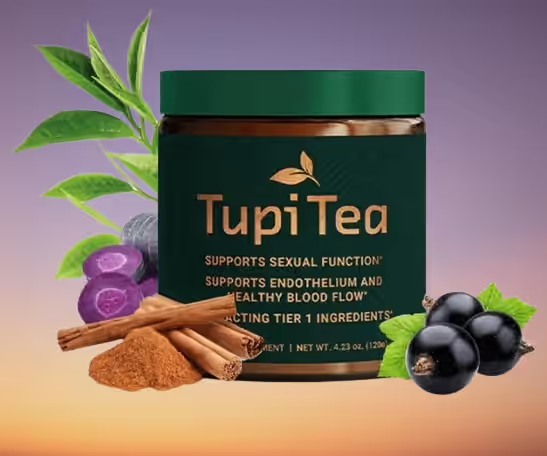Table of Contents
When you see the word ‘rose’ in a tea, what comes to mind? Maybe a delicate floral scent, or perhaps a hint of something sweet. But what about ‘rosehip’ tea? It sounds similar, but there’s actually a pretty big difference between the two. Let’s break down what makes rose tea and rosehip tea distinct, from where they come from to how they taste and what they can do for you. It’s more than just a petal versus a fruit; it’s about understanding the unique qualities each brings to your cup.
Key Takeaways
- Rose tea typically uses the petals of the rose flower, offering a mild, floral flavor and aroma, often used for relaxation and digestion.
- Rosehip tea is made from the fruit of the rose plant, known for its tart, slightly cranberry-like taste and high Vitamin C content.
- While both contain antioxidants, rosehips are a much richer source of Vitamin C, beneficial for immunity and reducing inflammation.
- Rose petals are often used in aromatherapy and perfumery for their scent and calming properties, while rosehips are valued for their oil in skincare.
- Brewing methods vary; rose petal teas might need cooler water and shorter steeps, whereas rosehip infusions often benefit from boiling water and longer steeping times.
Understanding Rose Tea vs Rosehip Tea
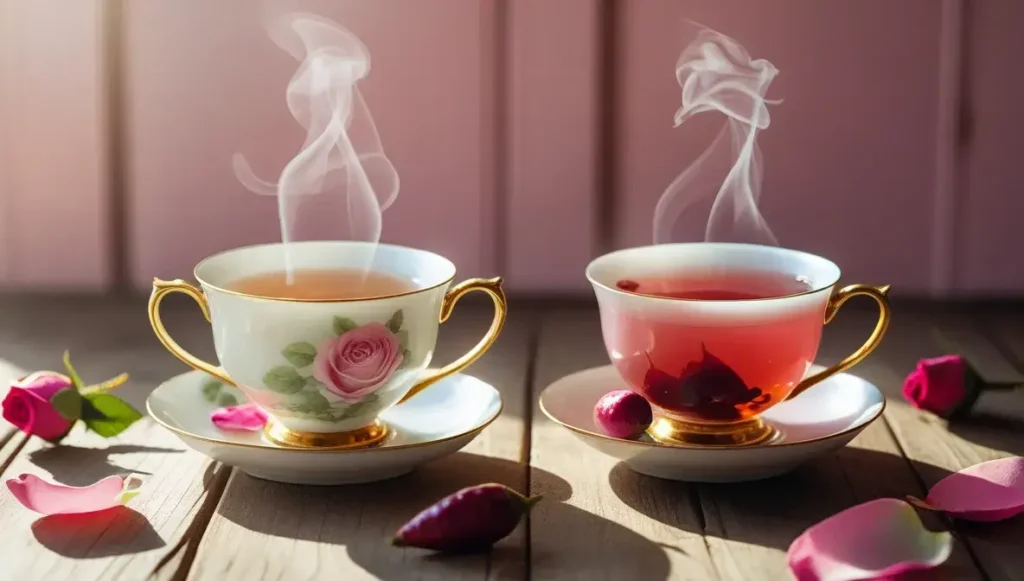
So, you’ve seen “rose tea” and “rosehip tea” on the shelves, and maybe you’re wondering if they’re the same thing. It’s a common question, and honestly, it’s easy to get them mixed up because they both come from the rose plant. But here’s the scoop: they’re actually quite different, both in what part of the plant they use and what they bring to your cup.
Botanical Origins Of Rose And Rosehips
When we talk about roses, we usually picture those beautiful, fragrant flowers. These are the petals that give us what’s often called “rose tea.” They’re used for their delicate aroma and subtle floral taste. On the other hand, rosehips aren’t the flower itself. They are the fruit of the rose plant, specifically the part that develops after the petals have fallen. Think of them as the rose’s seed pod, often round or oval, and typically a vibrant red or orange color.
The Fruit Versus The Flower
This distinction between the flower (petals) and the fruit (hips) is the main difference. Making rose tea from petals involves drying and using those lovely petals. It’s a process focused on capturing the flower’s essence. Rosehip tea, however, uses those dried fruits. This means you’re getting a different set of compounds and flavors. It’s like comparing tea made from lavender flowers versus tea made from elderberries – both from plants, but very distinct.
Key Differences In Appearance
Visually, the difference is pretty clear once you know what to look for. Rose petals, when dried for tea, are often thin, delicate, and papery, usually in shades of pink or red. They might be whole or broken into smaller pieces. Rosehips, on the other hand, are more substantial. They’re typically dried whole and look like small, shriveled fruits, often with a slightly fuzzy texture on the outside and seeds inside. When brewed, rose petal tea might have a very light, almost clear infusion, while rosehip tea often yields a more robust, reddish-amber color.
It’s important to remember that while both come from the same plant family, the part used dictates the final product. This difference in origin is why rose tea and rosehip tea have distinct flavor profiles and nutritional benefits. So, no, rose tea is not the same as rosehip tea, though both can be delightful additions to your tea collection.
👉 Experience the Premium Rose Tea That Redefines Pure Elegance 👈
Flavor Profiles And Culinary Uses
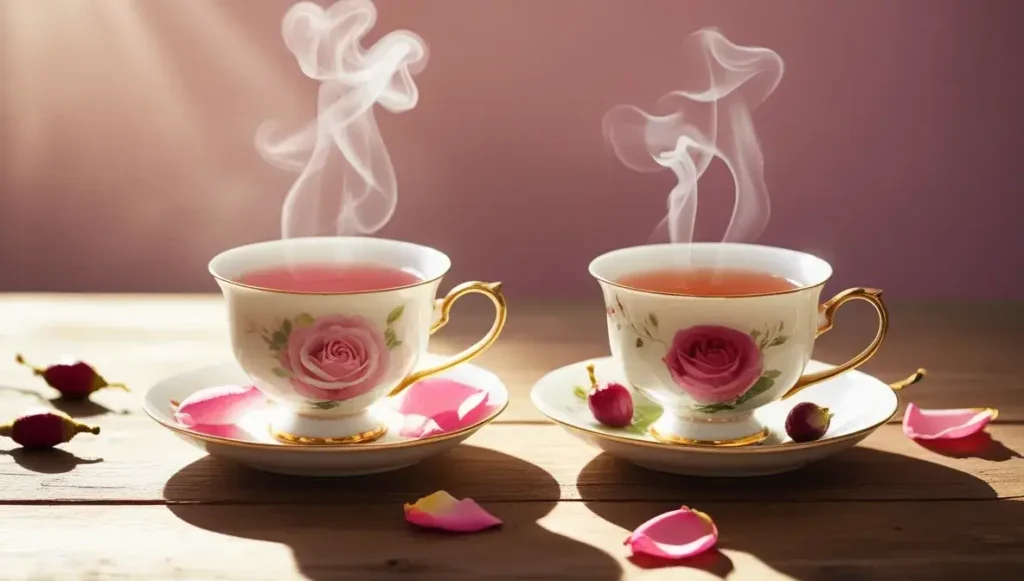
When you think about roses, you probably picture beautiful flowers with a lovely scent, right? And you’re not wrong! But when we talk about rose tea and rosehip tea, their flavors can be surprisingly different, and that affects how we use them in the kitchen.
The Delicate Taste Of Rose Petals
Rose petals, when used for tea, offer a really subtle, floral taste. It’s not overpowering at all; think of it as a gentle whisper of perfume in your cup. It’s often described as sweet and slightly perfumed, with a delicate aroma that can be quite calming. Because the flavor is so light, it pairs wonderfully with other mild ingredients. You’ll often find rose petals used in blends where they add a sophisticated floral note without stealing the show. They’re also fantastic in baked goods, desserts, and even cocktails where you want that hint of floral elegance.
The Tart And Fruity Notes Of Rosehips
Rosehips, on the other hand, are a whole different ballgame flavor-wise. Since they’re the fruit of the rose plant, they tend to have a more robust, fruity taste. The most common descriptor is tart, almost like cranberries or sour cherries. This tanginess makes them a great base for teas, especially when you want something a bit more zesty. They can be a bit sharp on their own, so they’re often blended with sweeter fruits or spices to balance them out. Think of them as the more vibrant, zippy cousin in the rose family.
Blending Rose And Rosehip In Teas
So, how do these two come together? Well, sometimes they don’t! You can have a tea made purely from rose petals or purely from rosehips. But when you blend them, you get something really interesting. Imagine the tartness of the rosehip being softened by the gentle floral notes of the rose petal. It creates a complex flavor profile that’s both refreshing and comforting.
Here’s a quick rundown of what to expect:
- Rose Petal Tea: Light, floral, subtly sweet, aromatic.
- Rosehip Tea: Tart, fruity, tangy, sometimes a bit earthy.
- Blended Tea: A balance of floral and fruity, with a complex, layered taste.
Because rosehips are so tart, they often need a little something extra to make them palatable as a standalone beverage. This is where blending with other ingredients, like sweet fruits or warming spices, really shines. Rose petals, with their delicate nature, are more about adding an aromatic and subtle flavor dimension.
Culinary uses really highlight these differences. Rose petals and rose water are common in desserts, pastries, and delicate drinks. Rosehips, with their vibrant flavor and high vitamin C content, are often used in jams, syrups, and more robust beverages where their tartness can be appreciated or balanced.
Nutritional Content Comparison
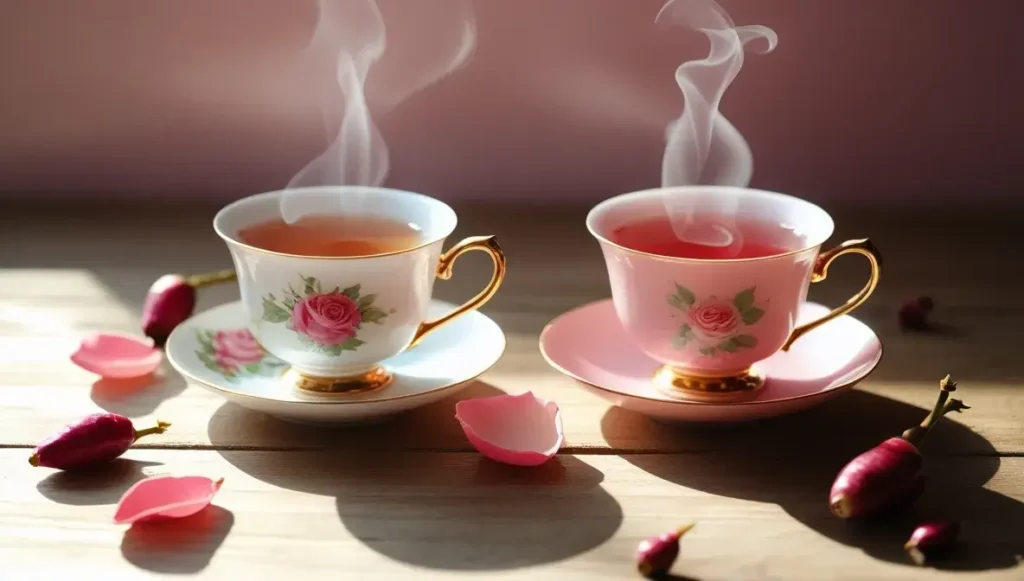
When we talk about rose tea and rosehip tea, it’s easy to think they’re pretty similar, but their nutritional profiles tell a different story. It really comes down to what part of the rose plant you’re using.
Vitamins and Antioxidants in Rose Petals
Rose petals, the fragrant part we often associate with romance and beauty, offer a more subtle nutritional contribution. They do contain some antioxidants, like flavonoids and polyphenols, which are good for your body. These compounds can help protect your cells from damage. However, they aren’t a powerhouse of vitamins.
- Antioxidants: Flavonoids, polyphenols
- Vitamins: Trace amounts, including some Vitamin C
The Rich Vitamin C Content of Rosehips
Now, rosehips are a whole different ballgame. These are the fruits of the rose plant, and they pack a serious nutritional punch, especially when it comes to Vitamin C. Seriously, they often have more Vitamin C than oranges! This makes them a fantastic choice for supporting your immune system and keeping your skin healthy. Beyond Vitamin C, rosehips also bring other beneficial vitamins to the table.
Essential Fatty Acids and Minerals in Rosehips
Rosehips don’t stop at vitamins. They’re also a source of healthy fats, specifically omega-3 and omega-6 fatty acids. These are important for things like heart health and keeping inflammation in check. Plus, you’ll find minerals like calcium and magnesium in them, which are vital for many bodily functions. It’s pretty amazing what these little fruits can do!
Here’s a quick look at what you might find:
| Nutrient | Rose Petals | Rosehips |
|---|---|---|
| Vitamin C | Low | Very High |
| Vitamin A | Minimal | Present |
| Vitamin E | Minimal | Present |
| Antioxidants | Moderate | High |
| Essential Fats | Negligible | Present |
| Minerals | Minimal | Present |
So, while rose petals add a lovely aroma and delicate flavor to tea, it’s the rosehip that truly shines when you’re looking for a significant nutritional boost, particularly for immune support and skin health. If you’re interested in the health benefits of rosehips, you might want to look into rose hip supplements for consistent intake.
It’s clear that the part of the plant matters a lot when it comes to what you’re getting in your cup. Rosehips are definitely the nutritional champions here.
👉 Discover the Premium Rosehip Tea That Transforms Everyday Wellness 👈
Health Benefits Of Rose And Rosehip Teas
Both rose flower tea and its cousin, rosehip tea, bring a lot to the table when it comes to feeling good. It’s not just about a nice drink; these teas have some real perks.
Rose Petal Benefits For Relaxation And Digestion
If you’re feeling a bit wound up, a warm cup of rose petal tea might be just the ticket. People have used rose petals for ages to help calm down and shake off stress. It’s thought that certain compounds in the petals have a relaxing effect, which can be super helpful after a long day. Beyond just chilling out, rose petals have also been traditionally used to help with tummy troubles. They can gently encourage your digestive system to work a bit better, making things feel more comfortable. It’s a mild effect, but often enough to make a difference.
Rosehip Benefits For Immunity And Inflammation
Now, let’s talk about rosehips. These little fruits pack a serious punch, especially when it comes to Vitamin C. Getting enough Vitamin C is key for keeping your immune system strong, helping your body fend off those pesky colds. Rosehips are also known for their anti-inflammatory properties. If you’re dealing with aches and pains, particularly from things like arthritis, a regular dose of rosehip infusion might offer some relief. It’s like a gentle way to tell your body to calm down those inflammatory responses.
Shared Antioxidant Properties
Here’s something cool: both rose petals and rosehips are loaded with antioxidants. Think of antioxidants as your body’s little helpers, fighting off damage from things called free radicals. This protection is good for your overall health and can play a role in preventing long-term issues. So, whether you’re sipping on rose flower tea or a rosehip brew, you’re getting a dose of these beneficial compounds. It’s a simple way to support your body from the inside out, and it makes for a really pleasant herbal tea for skin health too, thanks to all those good-for-you elements.
Applications Beyond Beverages
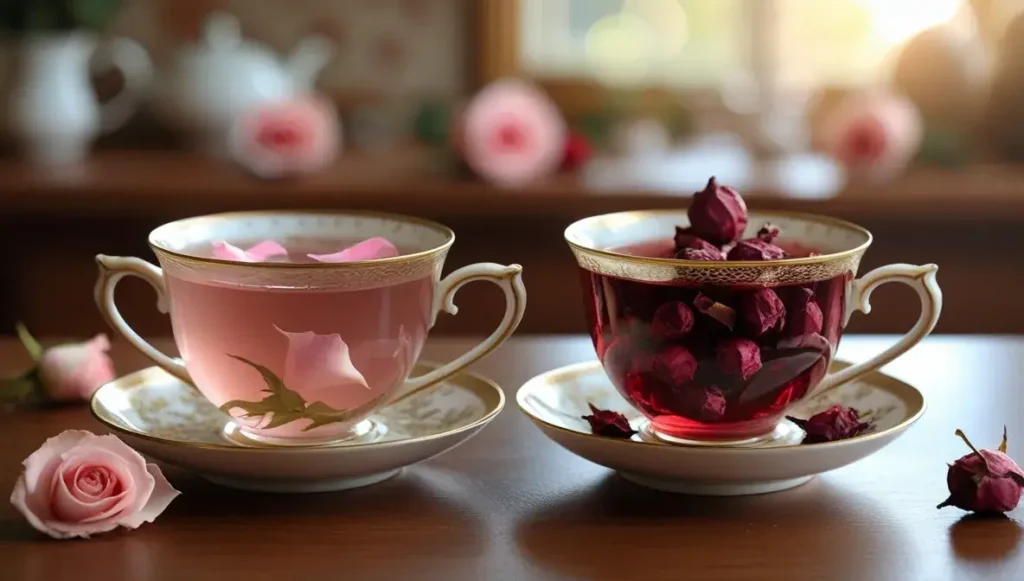
While we often think of rose and rosehip teas as delightful drinks, their uses stretch much further than just a warm cup. Both parts of the rose plant have found their way into various products, from beauty routines to household cleaners.
Rose Petals in Aromatherapy and Perfumery
Rose petals are famous for their scent, and this is no accident. The petals are where much of the rose’s fragrance comes from. This is why they’re a go-to ingredient for making perfumes and essential oils. When you smell a beautiful rose perfume, chances are it contains oil extracted from rose petals. In aromatherapy, the scent of rose is often used to help people relax and feel a bit more balanced emotionally. It’s also thought to help with headaches. Sometimes, people even use rose petal compresses on the skin to help minor cuts heal a little faster and calm down redness.
Rosehip Oil for Skincare and Anti-Aging
Rosehips, the fruit of the rose, are packed with good stuff, especially for your skin. Rosehip oil, pressed from the seeds inside the hips, is loaded with vitamins and fatty acids. It’s known for its ability to help with skin repair and can make skin look younger. The vitamins A and E, along with omega-3 and omega-6 fatty acids, work together to keep skin healthy, reduce inflammation, and improve its natural barrier. This makes rosehip oil a popular choice in many skincare products aimed at fighting signs of aging and improving skin texture.
Culinary Uses of Rose Water and Petals
Beyond just tea, rose petals and rose water are used in cooking and baking. They add a subtle floral flavor to desserts, drinks, and even savory dishes. Think of delicate cakes, flavored syrups, or even cocktails with a hint of rose. Rose water is particularly common in Middle Eastern and Indian cuisines. Rosehip powder can also be added to things like energy bars or smoothies for an extra nutritional boost and a slightly tart, fruity taste. It’s a way to add flavor and health benefits at the same time.
👉 Taste the Superior Quality of Our Certified Organic Rose Tea 👈
Brewing And Enjoying Rose Tea vs Rosehip Tea
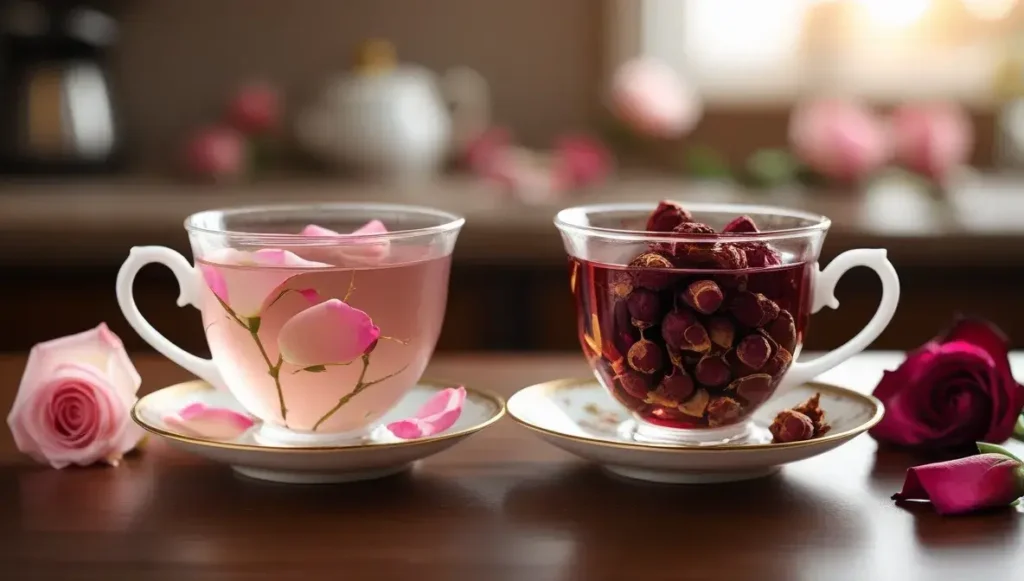
Steeping Guidelines For Rose Petal Teas
When you’re thinking about making tea from rose petals, remember that these delicate flowers need a gentle touch. The goal is to coax out their subtle floral aroma and flavor without making them bitter. For dried rose petals, a good starting point is to use about one to two teaspoons of petals per cup of hot water. The water temperature is key here; you don’t want it boiling furiously. Aim for water that’s just shy of boiling, around 175-185°F (80-85°C).
Pour the hot water over the petals and let them steep for about 3 to 5 minutes. Over-steeping can sometimes lead to a less pleasant taste, so keep an eye on the clock. If you’re using fresh rose petals, you might need a bit more, perhaps two to three tablespoons, and the steeping time might be slightly shorter. It’s all about finding that sweet spot where the fragrant notes come through. Remember, drinking rose petals is a sensory experience, so take a moment to enjoy the aroma before you sip.
Optimal Brewing For Rosehip Infusions
Rosehips, on the other hand, are a bit more robust. Because they are the fruit of the rose plant, they can handle hotter water and longer steeping times. This is why they often appear in herbal tea blends. For rosehip tea, you’ll typically want to use boiling water, around 212°F (100°C). Use about one to two teaspoons of dried rosehips per cup.
You can let these steep for a good 5 to 10 minutes, or even longer if you prefer a stronger, tarter flavor. Some people even simmer rosehips gently on the stovetop for a few minutes to really extract their goodness. This longer infusion time helps to release their tart, fruity notes and their beneficial compounds. Don’t be afraid to experiment a little to find what works best for your palate.
Considering Other Ingredients In Blends
When you’re dealing with teas that blend rose petals or rosehips with other ingredients, things can get a little more complex. For instance, if you have a black tea blended with rose petals, you’ll want to follow the brewing guidelines for black tea, which usually means using boiling water and steeping for about 3 to 5 minutes. The rose petals will add a floral nuance to the stronger tea base.
Conversely, if rosehips are part of a fruity herbal blend, you might stick to the longer, hotter infusion recommended for rosehips to get the most out of their tartness and vitamin C content. Always check the packaging for specific brewing recommendations, as the other ingredients in the blend will often dictate the best way to prepare your cup. It’s a bit of a balancing act to get the best flavor from all the components.
So, Rose Tea vs. Rosehip Tea: What’s the Takeaway?
Alright, so we’ve chatted about rose tea and rosehip tea. Remember, rose petals bring that lovely floral scent and taste, often used to make teas feel a bit more delicate and calming. Rosehips, on the other hand, are the fruit part, packing a punch with Vitamin C and a tart, fruity flavor, great for a health boost. While both come from the rose plant and offer some cool benefits, like antioxidants, they’re used for slightly different reasons in your cup. So next time you’re picking out a tea, you’ll know if you’re going for the fragrant petals or the zesty fruit!
👉 Awaken Your Body with This Powerful Breakthrough Rosehip Tea 👈
Frequently Asked Questions
What’s the main difference between rose tea and rosehip tea?
Rose tea is usually made from rose petals, giving it a mild, flowery taste and smell. Rosehip tea is made from the fruit of the rose plant, which tastes tart and fruity, a bit like cranberries. Rosehips are also packed with more vitamins.
Are rosehips flowers or fruits?
Rosehips are actually the fruit of the rose plant! They grow after the flower petals fall off and contain the seeds. They look a bit like small, round apples.
Which tea has more Vitamin C, rose or rosehip?
Rosehip tea is much richer in Vitamin C than rose petal tea. Rosehips have a lot more Vitamin C, even more than many fruits like oranges, which is great for your immune system.
Can I use rose petals and rosehips together in tea?
Yes, you can! Many teas blend rose petals and rosehips. The rose petals add a nice floral scent and flavor, while the rosehips give it a tangy, fruity kick and extra vitamins.
What are the health benefits of drinking rosehip tea?
Rosehip tea is known for being full of Vitamin C and antioxidants, which help your body fight off sickness and keep your skin looking good. It can also help reduce swelling and pain in your body.
Are rose petals good for anything besides tea?
Yes! Rose petals are used in things like perfumes and aromatherapy because of their lovely smell, which can help you relax. They’re also used in cooking to add a floral flavor to desserts and drinks, and in skincare for their soothing qualities.
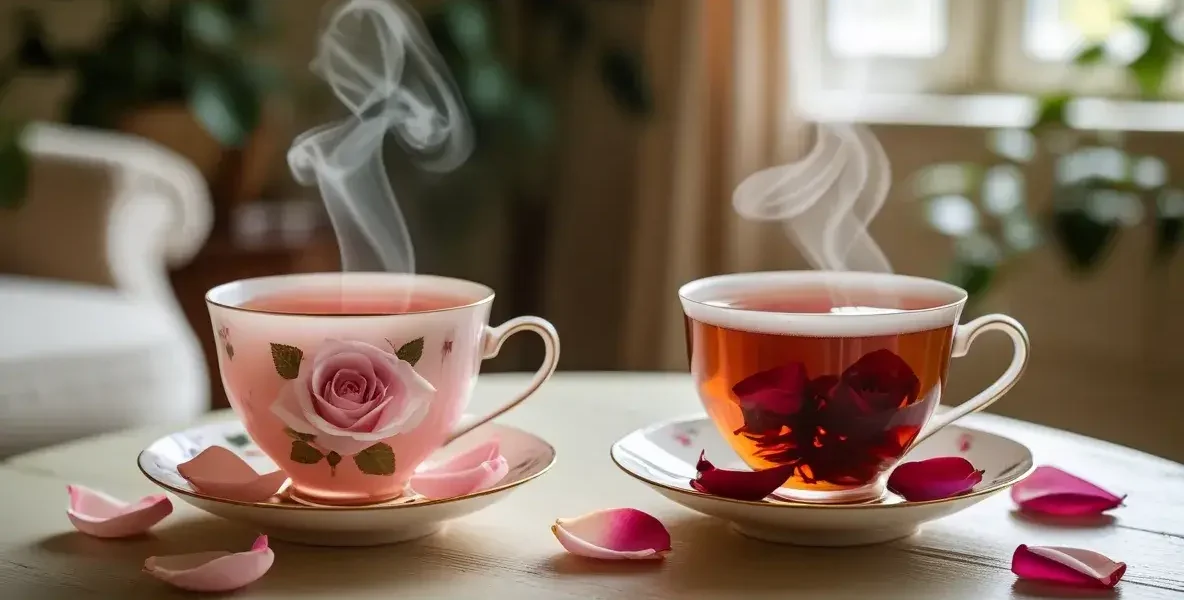

![Jasmine Tea vs Green Tea Benefits: Which Gives Better Health Results? [2025] jasmine tea vs green tea benefits](https://www.goteaworld.com/wp-content/uploads/2025/09/jasmine-tea-vs-green-tea-benefits-150x150.webp)







![Pu Erh Tea vs Green Tea: Which is Better for Daily Health? [2025] pu erh tea vs green tea](https://www.goteaworld.com/wp-content/uploads/2025/10/pu-erh-tea-vs-green-tea-150x150.webp)


